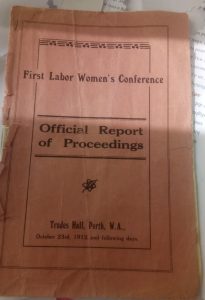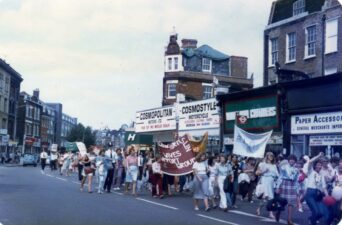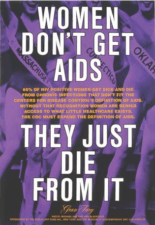Part 3
Women in trade unions in Western Australia in the early 1900s
This paper is a section of an article published in Marian Simms, Australian Women and the Political System , Longman Cheshire, 1984.
Robin Joyce
An apprenticeship served in the industrial wing of the labour movement, although a useful avenue for male aspirants, did not advance women to the same level. Cecilia Shelley, a long term secretary and organiser with the Hotel and Restaurants Employees Union , was a particularly important influence in the Australian Labor Party (ALP).
Other women also filled important positions on union executives and have been largely ignored.
In eight unions between 1914 and 1928 women filled every position from Trustee to President, Secretary or paid Organiser. It is true that more women became Trustee, a less influential position, than that of organiser or Secretary. However, it is important to note that women did not remain rank and file members with all male executives making the decisions in unions.
By 1928 sixty-two Trustee positions had been held by women, some by the same woman for several terms, and twenty-one Vice-presidential positions had been won by women. Presidential or chairing positions had been held by women twelve times and women had been Treasurer twenty-five times. \most importantly, women held the most influental position of union Secretary twenty-eight times between 1914 and 1928. Of these, Cecilia Shelley was Secretary every year between 1920 and 1928, a position she held until her retuirement in the 1960s, except one year when she became President and her husband became Secretary.

Pansy J. Hawkes was the first Secretary of the Cleaners, Caretakers and Lift Attendants Union, followed by another woman, Sylvia Donaldson, in 1921. Sylvia Donaldson retained the position until she became an Inspector of Factories in 1923. Ivy Pirani replaced her husband as Secretary of the Hospital and Asylum Employees Union in 1923 and retained the position throughout the 1920s and early 1930s. The Hotel, Club, Caterers Employees Union (Goldfields Division) , like Cecilia Shelley’s metropolitan division, had a history of women Secretaries, with May Grace holding the position between 1925 and 1927, following Helen McEntrye’s term from 1923.
Helen McEntyre, like her sister, Kathleen, was one of the less well recorded women but was active throughout the 1920s and 1930s. She was involved in militant action on behalf of the cafetraia nd hotel staff in the 1920s strikes in the industry. Although she was fined and criticised in the press for demonstrating publicly and using ‘unsuitable language’, (West Australian, C 1924), the sisters were strong supporters of ‘Shelley’s Army’ in the stormy industrial period surrounding women’s claims for improved conditions in the catering trade. Helen McEntrye was also active in the Labor Women’s Organisations , a member of the ALP State Executive and some of its committees and an Organiser for the Hotel and Restaurant Employees Union. In 1933 she proxied for May Holman MP at a committee inquiring into the employment of women in industry. Kathleen McEntrye was an active member of the Clerical Workers’ Union and although well remembered by women such as Cecilia Shelley (Interviews by Robin Joyce, 1970s) there are few records of her work.
Annie Warren was another activist who combined ALP and union work. She became Assistant Secretary of the South West Clothing Trades Union after a two year term as Treasurer. In 1926 she filled both the position of Assistant Secretary and Secretary. This union had a proud history of women’s executive involvement from its inception in 1917. May Mullens was the first Vice-Chairman, Annie Warren began her work with the union then, as Treasurer and (Miss) A. Prosser was a Trustee. They retained their positions in 1918 and were joined by (Mrs) M. Lynch as Chairman. In 1927 the union was dominated by women, with Annie Warren, again Secretary and Treasurer combined, Lily Caine as Chairman, (Miss) B. O’Doherty , Vice Chairman and Jessie G. Roper again a Trustee.
Despite the sketchy nature of the information about women’s political work in the industrial wing of the ALP it can be established that they made a major contribution to organising their labour through standing for, and winning official positions in their unions. This level of activity gave them authority beyond that of a political housekeeper, demanding of them a commitment to unionism beyond that of the usual rank and file member. Such commitment demanded that they promote themselves as worthy of support in prominent positions, at the same time as demonstrating they had the skills for office.
The evidence that women have always been political activists as well as housekeepers in the Western Australian labour movement, in the party and industrial wings, and thus have served apprenticeships yet received few important promotions is not only a matter of concern but one from which contemporary activists can learn. Perhaps the most important is that women were politically active from the inception of the labour movement in Western Australia. They did not confine themselves to making the tea and serving the scones, although these were worthy tasks contributing to the workings of conferences and meetings. Women in the labour movement have a varied history that needs to be recognised.

This paper was written in the 1970s, and now provides only a backdrop for the changes that have taken place in the Australian Labor Party, most substantially from the 1980s. In that period state branches introduced affirmative action programmes, which were entrenched at the 1981 National Conference. Since then 90 women have become Federal Members or Senators. There have been women ministers and women in Cabinet and Julia Gillard became the first Australian woman Prime Minister in 2010. The Australian Council of Trade Unions has had two women Presidents. Not enough, of course, but more than accepted as politicians rather than political housekeepers.



